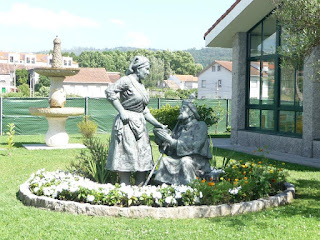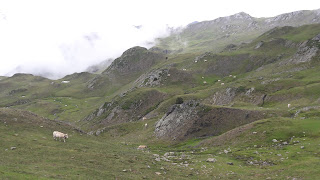3. Camino or the Road
Translated by Jolanta Czaicka-Kotlarczyk
Camino. The sound of this word alone evokes the thrill of excitement. It is just a road, but what a road it is! I know a lot of people, sometimes not so young, who go there every spring. From Silesia to Santiago, riding their bikes or walking. The distance is 3,500 km.
When back home, they are dreaming the whole winter about their next trip. It is because the Camino draws one in, makes them dependent, forces on them a certain way of thinking that becomes their own. One just starts to like it. Difficulties and exhaustion are not a problem, because one realizes they are a part of the deal.
Sometimes you walk alone and are enjoying it, but if someone wants to join you for a while, it is ok, too.
The most important thing you learn is the ability to notice special things about these people. You greedily catch certain moments and make the most of them. It is a “friendship in a nutshell”. It can happen if each of you gives the best things you have, and the Camino people know to do it. They have acquired the skill of living in the present moment. Right here, right now. No “before” and “after”, because you know that each of you will go your own way, and at your own pace. It doesn’t make you sad that your new friendship was so brief, because it brought just the joy and warmth you needed. You do not put anything off for later, because no one knows if there will be a “later,” and what could be in there for us.
Camino teaches us to trust people, the world and itself, the Road. One can say it teaches us to trust in God (you can use different names instead). Camino helps you believe that in any case you will end up okay, that there are no wrong roads, only roundabout ways to eventually get to the same destination. You learn not to regret your choices, which made you go around, because sometimes it is the only way to notice things that have been left out. You learn that you don’t have to know the whole route to reach the destination. You just have to trust the Road.
Camino teaches us how to listen to ourselves and to our own intuition. Our intuition is like the sound of nature. It is so easy to ignore it, because it is as quiet as the rustle of leaves, the sound of raindrops, or the chirping of crickets; but if you listen carefully, it will tell you important things about yourself. It is really important to listen, because such knowledge will help you to like yourself, to be kind to yourself, and to take care of yourself.
Before I started the Road, I really needed to learn a few things. After many years of complicated relationships and difficult break-ups, I found myself unable to answer basic life questions. When I was grocery shopping, I walked through the store, repeating a mantra: “What do I really like to eat?” At the hardware store, I was standing in front of a shelf of wall paint, struggling to decide what color I’d like to have on the walls. Then came the questions about my favorite activities, hobbies, dreams, wishes, or what relaxes me. These were the basic questions, the questions teenagers often keep asking themselves. Being an adult woman, I did not know the answers.
I wanted to walk the Camino to find my true self. To listen to the silence, which I found out was my favorite music. Actually, this discovery shouldn’t surprise me after so many years spent with the hearing impaired in their silent, but so visually abundant, world. When I walked the Camino, I learned the faded colors of summer were so appealing to me, and that the simple lifestyle was my favorite. I started believing my inner life has its own, unique value, and that I should protect it. I learned to see the admiration for these things in other people’s faces. Yes, the human face is like a mirror, which reflects our soul. And Camino Amigos are invaluable as “mirrors”.
Additional Information:
Camino. The sound of this word alone evokes the thrill of excitement. It is just a road, but what a road it is! I know a lot of people, sometimes not so young, who go there every spring. From Silesia to Santiago, riding their bikes or walking. The distance is 3,500 km.
When back home, they are dreaming the whole winter about their next trip. It is because the Camino draws one in, makes them dependent, forces on them a certain way of thinking that becomes their own. One just starts to like it. Difficulties and exhaustion are not a problem, because one realizes they are a part of the deal.
Sometimes you walk alone and are enjoying it, but if someone wants to join you for a while, it is ok, too.
The most important thing you learn is the ability to notice special things about these people. You greedily catch certain moments and make the most of them. It is a “friendship in a nutshell”. It can happen if each of you gives the best things you have, and the Camino people know to do it. They have acquired the skill of living in the present moment. Right here, right now. No “before” and “after”, because you know that each of you will go your own way, and at your own pace. It doesn’t make you sad that your new friendship was so brief, because it brought just the joy and warmth you needed. You do not put anything off for later, because no one knows if there will be a “later,” and what could be in there for us.
Camino teaches us to trust people, the world and itself, the Road. One can say it teaches us to trust in God (you can use different names instead). Camino helps you believe that in any case you will end up okay, that there are no wrong roads, only roundabout ways to eventually get to the same destination. You learn not to regret your choices, which made you go around, because sometimes it is the only way to notice things that have been left out. You learn that you don’t have to know the whole route to reach the destination. You just have to trust the Road.
Camino teaches us how to listen to ourselves and to our own intuition. Our intuition is like the sound of nature. It is so easy to ignore it, because it is as quiet as the rustle of leaves, the sound of raindrops, or the chirping of crickets; but if you listen carefully, it will tell you important things about yourself. It is really important to listen, because such knowledge will help you to like yourself, to be kind to yourself, and to take care of yourself.
Before I started the Road, I really needed to learn a few things. After many years of complicated relationships and difficult break-ups, I found myself unable to answer basic life questions. When I was grocery shopping, I walked through the store, repeating a mantra: “What do I really like to eat?” At the hardware store, I was standing in front of a shelf of wall paint, struggling to decide what color I’d like to have on the walls. Then came the questions about my favorite activities, hobbies, dreams, wishes, or what relaxes me. These were the basic questions, the questions teenagers often keep asking themselves. Being an adult woman, I did not know the answers.
I wanted to walk the Camino to find my true self. To listen to the silence, which I found out was my favorite music. Actually, this discovery shouldn’t surprise me after so many years spent with the hearing impaired in their silent, but so visually abundant, world. When I walked the Camino, I learned the faded colors of summer were so appealing to me, and that the simple lifestyle was my favorite. I started believing my inner life has its own, unique value, and that I should protect it. I learned to see the admiration for these things in other people’s faces. Yes, the human face is like a mirror, which reflects our soul. And Camino Amigos are invaluable as “mirrors”.
Additional Information:
- Santiago de Compostella Cathedral, considered one of the greatest achievements of Roman architecture in Spain. The façade is in Baroque style. Pilgrims from different countries started coming here in the 11th Century. They ate what people had given them, and slept wherever it was possible. They walked roads and paths, and crossed the fields, meadows, forests, and rivers. They walked in the heat, rain, and through windstorms and blizzards. They walked for months just to touch the saint so he could protect them against disease and disaster, which was so common in medieval times. God seemed distant, austere and inaccessible. That’s why they sought contact with saints. Such contact had to be tangible, so they pilgrimaged to places with holy relics.
- Credencial (the “pilgrim’s passport”) is the document required to get a spot at the albergues de pelegrinos (shelters for pilgrims). A small fee and a sleeping bag are required. Beds are not always guaranteed, but there are mattresses available. Stamps (sellos) validating the finished route from the preceding day (at least 5 km) are required.
- Long ago the pilgrims were guided by the Sun. Now, the routes are marked with special signs: shells in Spain, and yellow arrows in Portugal. In this picture, these signs are combined.
- The pilgrims walk alone or in small groups. They can ride a bike or a horse.
- The signs along the road.
- The Camino trails lead through Europe as a system of routes that meet in Santiago de Compostella. Why there? Because there is a tomb of Saint James, one of the apostles, in the cathedral.


Komentarze
Prześlij komentarz